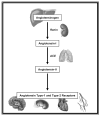The renin angiotensin system and the metabolic syndrome
- PMID: 20381510
- PMCID: PMC2886177
- DOI: 10.1016/j.physbeh.2010.03.018
The renin angiotensin system and the metabolic syndrome
Abstract
The renin angiotensin system (RAS; most well-known for its critical roles in the regulation of cardiovascular function and hydromineral balance) has regained the spotlight for its potential roles in various aspects of the metabolic syndrome. It may serve as a causal link among obesity and several co-morbidities. Drugs that reduce the synthesis or action of angiotensin-II (A-II; the primary effector peptide of the RAS) have been used to treat hypertension for decades and, more recently, clinical trials have determined the utility of these pharmacological agents to prevent insulin resistance. Moreover, there is evidence that the RAS contributes to body weight regulation by acting in various tissues. This review summarizes what is known of the actions of the RAS in the brain and throughout the body to influence various metabolic disorders. Special emphasis is given to the role of the RAS in body weight regulation. The paper represents an invited review by a symposium, award winner or keynote speaker at the Society for the Study of Ingestive Behavior [SSIB] Annual Meeting in Portland, July 2009.
2010 Elsevier Inc. All rights reserved.
Figures



Similar articles
-
The renin-angiotensin system: a link between obesity, inflammation and insulin resistance.Obes Rev. 2012 Feb;13(2):136-49. doi: 10.1111/j.1467-789X.2011.00942.x. Epub 2011 Oct 31. Obes Rev. 2012. PMID: 22034852 Review.
-
The renin-angiotensin system in adipose tissue and its metabolic consequences during obesity.J Nutr Biochem. 2013 Dec;24(12):2003-15. doi: 10.1016/j.jnutbio.2013.07.002. Epub 2013 Oct 9. J Nutr Biochem. 2013. PMID: 24120291 Review.
-
The renin-angiotensin system: a target of and contributor to dyslipidemias, altered glucose homeostasis, and hypertension of the metabolic syndrome.Am J Physiol Heart Circ Physiol. 2012 Mar 15;302(6):H1219-30. doi: 10.1152/ajpheart.00796.2011. Epub 2012 Jan 6. Am J Physiol Heart Circ Physiol. 2012. PMID: 22227126 Free PMC article. Review.
-
Role of the renin-angiotensin- aldosterone system in the metabolic syndrome.Contrib Nephrol. 2006;151:122-134. doi: 10.1159/000095324. Contrib Nephrol. 2006. PMID: 16929137 Review.
-
Glucagon regulation of energy metabolism.Physiol Behav. 2010 Jul 14;100(5):545-8. doi: 10.1016/j.physbeh.2010.03.019. Epub 2010 Apr 8. Physiol Behav. 2010. PMID: 20381509 Review.
Cited by
-
An update on angiotensin-converting enzyme 2 structure/functions, polymorphism, and duplicitous nature in the pathophysiology of coronavirus disease 2019: Implications for vascular and coagulation disease associated with severe acute respiratory syndrome coronavirus infection.Front Microbiol. 2022 Nov 28;13:1042200. doi: 10.3389/fmicb.2022.1042200. eCollection 2022. Front Microbiol. 2022. PMID: 36519165 Free PMC article. Review.
-
Molecular neuroendocrine targets for obesity therapy.Curr Opin Endocrinol Diabetes Obes. 2010 Oct;17(5):441-5. doi: 10.1097/MED.0b013e32833c3013. Curr Opin Endocrinol Diabetes Obes. 2010. PMID: 20585249 Free PMC article. Review.
-
Angiotensin-converting enzymes play a dominant role in fertility.Int J Mol Sci. 2013 Oct 21;14(10):21071-86. doi: 10.3390/ijms141021071. Int J Mol Sci. 2013. PMID: 24152441 Free PMC article. Review.
-
Influence of gestational salt restriction in fetal growth and in development of diseases in adulthood.J Biomed Sci. 2016 Jan 20;23:12. doi: 10.1186/s12929-016-0233-8. J Biomed Sci. 2016. PMID: 26787358 Free PMC article. Review.
-
Vitamin D/VDR regulates peripheral energy homeostasis via central renin-angiotensin system.J Adv Res. 2021 Feb 2;33:69-80. doi: 10.1016/j.jare.2021.01.011. eCollection 2021 Nov. J Adv Res. 2021. PMID: 34603779 Free PMC article.
References
-
- James WPT. The epidemiology of obesity: the size of the problem. Journal of Internal Medicine. 2008;263(4):336–352. - PubMed
-
- Ogden CL, Carroll MD, Curtin LR, McDowell MA, Tabak CJ, Flegal KM. Prevalence of Overweight and Obesity in the United States, 1999–2004. JAMA. 2006;295(13):1549–1555. - PubMed
-
- Jayasooriya AP, Mathai ML, Walker LL, Begg DP, Denton DA, Cameron-Smith D, Egan GF, McKinley MJ, Rodger PD, Sinclair AJ, et al. Mice lacking angiotensin-converting enzyme have increased energy expenditure, with reduced fat mass and improved glucose clearance. Proceedings of the National Academy of Sciences. 2008;105(18):6531–6536. - PMC - PubMed
-
- Massiera F, Seydoux J, Geloen A, Quignard-Boulange A, Turban S, Saint-Marc P, Fukamizu A, Negrel R, Ailhaud G, Teboul M. Angiotensinogen-Deficient Mice Exhibit Impairment of Diet-Induced Weight Gain with Alteration in Adipose Tissue Development and Increased Locomotor Activity. Endocrinology. 2001;142(12):5220–5225. - PubMed
Publication types
MeSH terms
Substances
Grants and funding
LinkOut - more resources
Full Text Sources
Other Literature Sources
Medical

